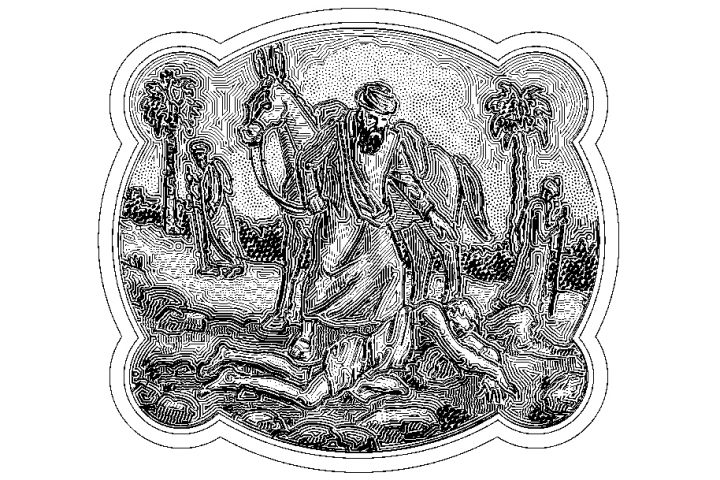Books Reviewed
A review of The Invaders: How Humans and Their Dogs Drove Neanderthals to Extinction, by Pat Shipman
We describe our connection to modern dogs, the most expressive of any animal species that interacts with man, with anthropomorphic expressions such as “love” and “friendship.” No simple owner-pet relationship, for example, can explain the heart-rending photo of a fallen U.S. Navy SEAL’s Labrador Retriever lying in front of his flag-draped casket. We bred them to be so expressive, of course, but only in the last two centuries or so did we actively shape Canis lupus familiaris into highly differentiated breeds, each filling a specific psychic need or role, from lapdog to bird retriever.
For thousands of years before that, however, our relationship with dogs was driven less by the specialization and leisure inherent in modern society than by environmental competition. An exchange of convenience seems to have precipitated our taming of the gray wolf, the first animal or plant species humans domesticated.
That part of the story is well known. What we are now learning, thanks to advanced genetic testing and some fascinating fossil discoveries, is not merely that our relationship with wolf-dogs goes back farther than anyone imagined, but that the alliance with dogs itself may have been the key to our survival as a species.
The question is not merely “why dogs,” but why did we and dogs win the evolutionary game at the expense of so many competitors? That is the puzzle tackled by Pat Shipman, a paleoanthropologist retired from Penn State University, in The Invaders: How Humans and Their Dogs Drove Neanderthals to Extinction. The subtitle is, in two ways, a bit misleading. First, dogs only appear three-fourths of the way through the book, after long and detailed discussions of ecosystems, isotopic testing, and climatic change. Second, Shipman acknowledges that it cannot be proven from the limited number of remains so far discovered that humans and dogs drove Neanderthals to extinction; and that the scenario does not fit the evolutionary time frame exactly. Nonetheless, her argument is wonderfully provocative.
Shipman’s big question is the age-old riddle of why the Neanderthals died out. Once seen as largely insensate brutes, Neanderthals are now viewed increasingly as intelligent hominins, well adapted to their environment, who may have had language and rudimentary culture. Starting around 250,000 years ago they inhabited Eurasia, from the Levant through the central European plain to the Atlantic coasts of Spain. Then, some 50,000 years ago, a new hominin species arrived in Eurasia from Africa, Homo sapiens. Within 5,000 years or so, the Neanderthals were no more.
* * *
Homo sapiens is what biologists call an invasive species. Not only the Neanderthals, but all the “megafauna” of the late Pleistocene era disappeared almost as quickly. Such predators as woolly mammoths, cave bears, and sabertooth tigers—all of which had a relatively inflexible diet, forcing them to compete directly with the new humans for animal food sources—either became prey themselves or simply died out. A new apex predator had fundamentally reordered the ecosystem. Or, to be more precise, two apex predators now sat atop the Pleistocene food chain and, in what almost certainly was a biological first, formed a working partnership that combined their comparative advantages into a lethally efficient survival machine.
Until recently, scientists believed that humans began domesticating wolves some 18,000 years ago. As the theory had it, the tamer wolves among those that had been camp followers and scavengers were kept around, and eventually bred amongst themselves. Sites in central Europe, however, have been providing evidence that domestication started much earlier. Morphological comparison of canid skulls now leads Shipman and some other paleoanthropologists to believe that dogs first became genetically and behaviorally distinct from wolves 36,000 years ago. If they’re correct, dogs appeared just a few thousand years after the last Neanderthal died, and well before the Pleistocene megafauna became extinct.
The domestication of what Shipman calls a “living tool” gave obvious advantages to early humans. Wolves could hunt prey for long distances and keep them at bay when cornered or exhausted; but moving in for the kill was dangerous when the prey was a woolly mammoth or rhinoceros. Humans, on the other hand, could not hunt nearly as well, but with thrown spears could kill far more efficiently, and could strip more meat off dead animals quickly. The end result was more food, an increase in protein, for both predator groups. The effect of this lethal partnership was to cause what biologists call a “crash,” which led to the extinctions of the competing species.
* * *
The sample size underpinning such dramatic claims is small. Yet what is missing is also significant. There are no Neanderthal sites yet found that contain canid remains. For whatever reason, it appears that Neanderthals did not, or could not, partner with wolf-dogs—if they even existed then—or any type of wolves. On the other hand, a stunning find from a Homo sapiens site in the Czech Republic yielded a fossilized wolf-dog skull with what appears to be a piece of mammoth bone ceremoniously inserted into its mouth. More significantly, new discoveries of what Shipman calls “megasites,” containing the remains of dozens of mammoths, indicate that far larger groups of animals were slaughtered and processed by early humans than ever were by Neanderthals. And those sites have been found to include wolf-dogs’ remains, though not with the telltale marks of having been butchered themselves.
Of course, what happened those millennia ago will never be known for sure. Yet Shipman proposes that a combination of climatic change, a cooling of the Eurasian landmass 39,000 years ago, and the loss of food sources for Neanderthals reduced their habitable areas. Less able than humans to adapt to such sudden changes in their environment, the Neanderthals eventually succumbed. They were not hunted out of existence or absorbed into the early human population, though some interbreeding did occur. They were losers in a much larger alteration in Eurasia’s ecosystem that transformed the late Pleistocene era. Wolf-dogs may have emerged after the Neanderthals vanished, but they appear almost certainly to have been part of the broader spread of early humans.
Can the triumph of Homo sapiens truly be laid at the paws of man’s best friend? Early humans were already more adaptable and more intelligent than any hominin before them, but intense competition for food against a series of fearsome predators meant that they would have to fight every step of their way up the ecosystem ladder. Without the advantages of canid partners, humans might not have spread so quickly, nor extinguished so many competitors, meaning that human settlement in the succeeding Holocene era, considered to have begun 11,700 years ago, might have been both slower and more sporadic.
* * *
What is missing in the paleoanthropological record is an understanding of how the Homo sapiens-Canis lupus mechanism actually worked. Obviously, over long periods of time, those canids that were unable to assimilate to the partnership—too violent to be domesticated or too inefficient to be hunters—were bred out of the wolf-dog population. That was the evolutionary road to pacification and eventually to the dogs we know today. Such culling continues in urban and rural areas alike, making modern humans canine breeders and domesticators similar to their prehistoric ancestors. But back in the Pleistocene, how were dogs, which were still largely wild, actually used in the hunt?
Here, Shipman advances a bolder, ultimately unprovable hypothesis: the whites of early human eyes allowed for nonverbal communication, as the direction of the human gaze could be followed by observers. Noting that modern dogs readily follow their masters’ gaze, unlike other canids and even apes, Shipman proposes that wolf-dogs might have been able to pick up on directional clues from humans, adding some efficiency to the hunt. At the same time, though, she writes that old-fashioned brutality might also have helped tame wolf-dogs into living tools, noting the number of injured fossil skulls of proto-dogs found at human sites.
The biological framework adopted by Shipman has some fervent partisans. Although she is careful except in a few instances not to extrapolate too much from the nature of our distant ancestors to contemporary human behavior, her argument about the invasive nature and lethality of Homo sapiens shades into current debates over the destruction wrought on nature by man. She starts and ends her book with a call for us to reflect on our impact on the planet; but radical environmentalists will no doubt want to press further, seeking a scientifically based justification for their condemnation of human society.
It might thus be better to conceive of humans not as an invasive species—after all, we are talking about every living being’s desire to survive—but rather as a particularly successful competitive species. “Competition biology” is therefore a better conceptual framework than invasion biology, and describes more accurately the interplay within an ecosystem that is finding its equilibrium. It also provides more insight into the human-dog partnership, by stressing the unique aspect of two apex competitors joining forces, and almost wholly by volition on both parts, as far as we can speculate.
* * *
Thus, Shipman’s book ends with the story’s real beginning. The Invaders provides tantalizing glimpses into the biological triumph of man, but also illuminates his subsequent development. Rewriting human evolution as a story of man and dog partnered on every continent, through every age, in every society, ultimately must cause us to rethink our definition of being human. Men and dogs may well have been lethally destructive, but to focus on the losses inflicted by their partnership is to ignore everything it subsequently made possible. It may not be hyperbole to say that dogs made us human, that they did not merely make possible our survival, as important as that was, but provided a significant part of the security that allowed civilization itself to arise, whether in the Nile Delta, where pictures of dogs are incised along with hieroglyphics, or in later empires on the Eurasian landmass. Those achievements, in turn, provided the fertile ground for the flourishing of human culture’s arts and sciences.
Even today, untold thousands of dogs still serve in working roles that make possible everything from herding to war fighting. In part because of the labor always undertaken by dogs, at some point in the recent past, no more than a few hundred years ago, we decided to make our partners into pets, from living tools to “animal companions.” Yet in their genes they still carry the encoding that drives them to protect us, and to form an emotional attachment that secures what they need to survive better than they can on their own. In the process, they remind us of the first partnership that enabled our ancestors to thrive on the slow, arduous journey out of the cave and into the sunlight.







